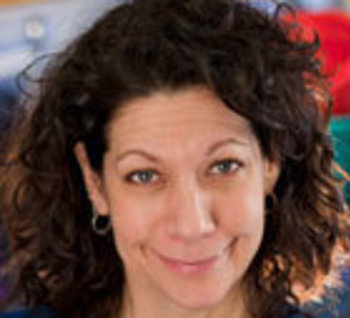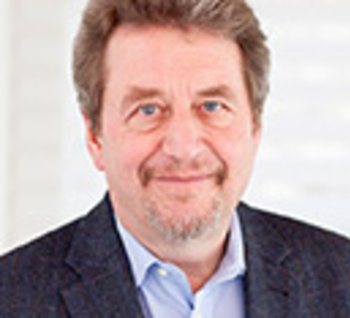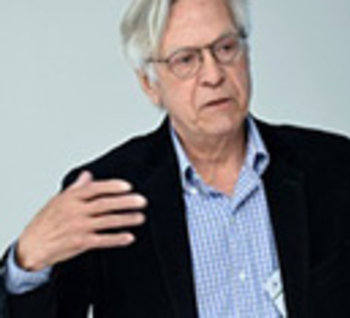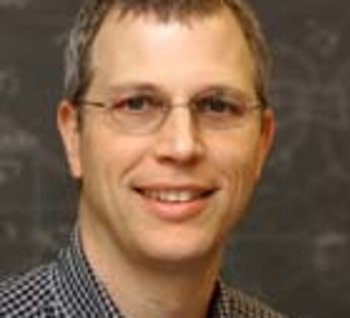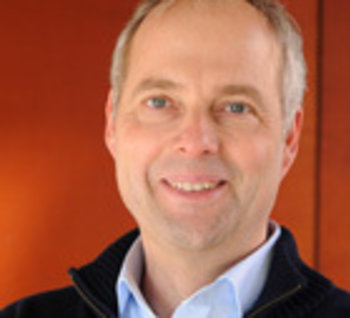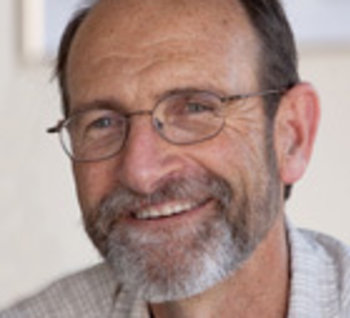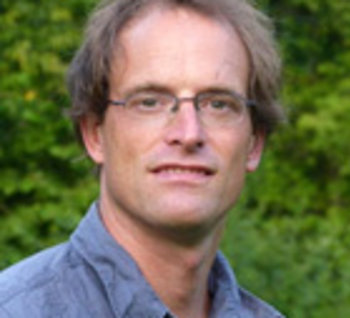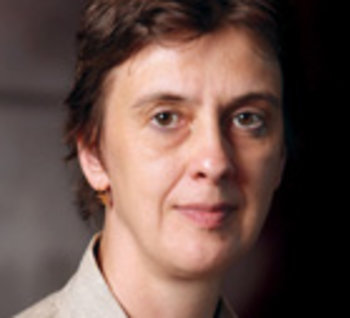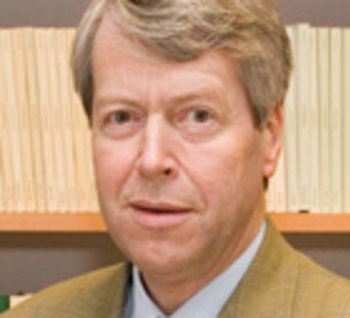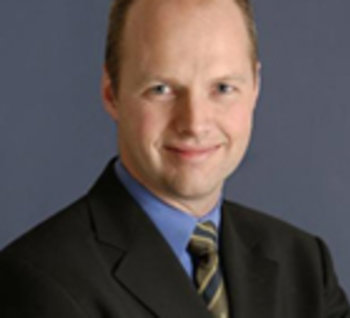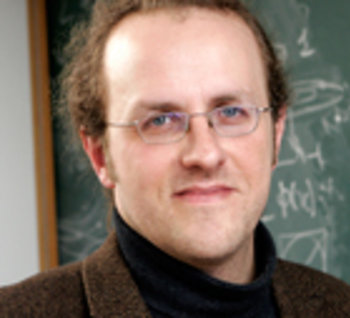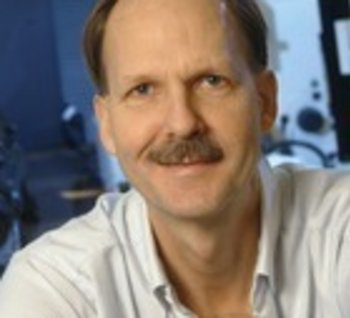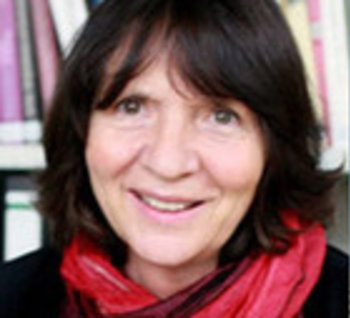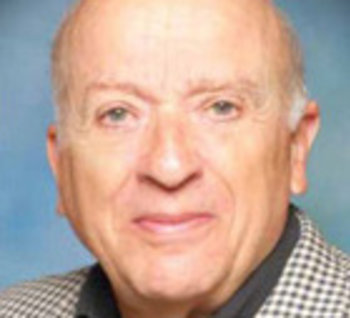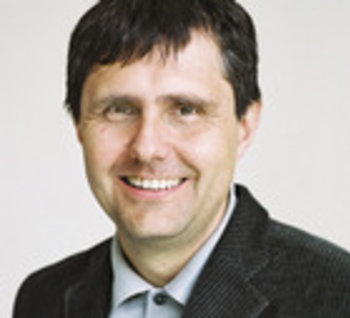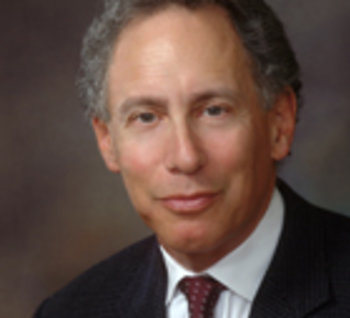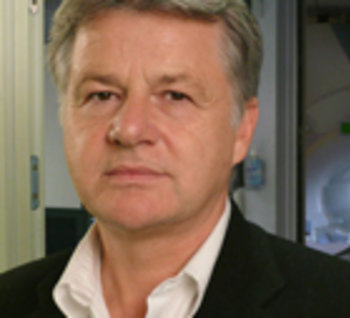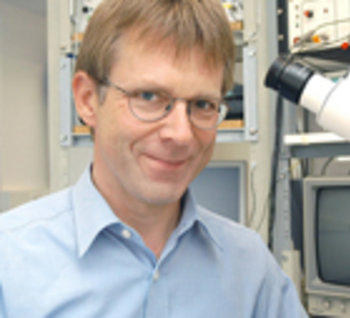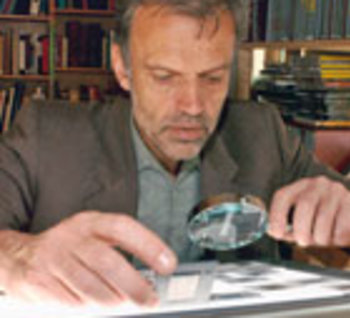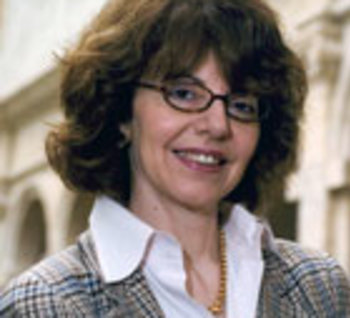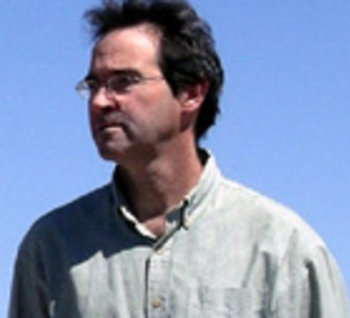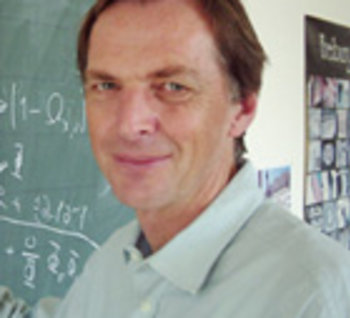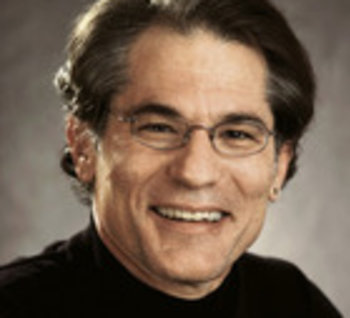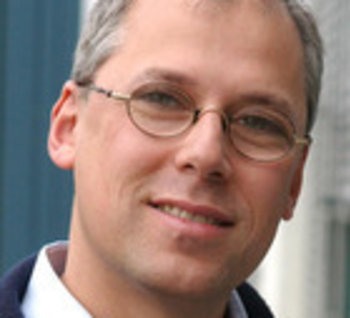One award - two winners
From 2004 to 2016, the Max Planck Research Award was conferred annually to two internationally renowned scientists, one of whom worked in Germany and one of whom worked abroad.
Calls for nominations for the award were invited on an annually rotating basis in specific sub-areas of the natural sciences and engineering, the life sciences and the human and social sciences. The objective of the Max Planck Society and the Alexander von Humboldt Foundation in presenting this joint research award was to give added momentum to specialist fields that were either not yet established in Germany or that deserved to be expanded.
Award winners 2016: Pioneering research into the sensory perception of organisms
The winners of the Max Planck Research Award are investigating how organisms perceive their environment. Bonnie L. Bassler focusses on bacteria. The US researcher played a major role in the discovery that Earth’s most ancient unicellular organisms communicate with one another via chemical signalling molecules. The amount of the released signal molecule increases with increases in the number of bacterial cells present. Groups of bacterial cells simultaneously detect the accumulated signal molecules, change their global gene expression patterns, and launch collective activities.
The Hawaiian bobtail squid Euprymna scolopes uses symbiotic bacteria as an invisibility cloak. When the squid goes hunting near the ocean surface under the full moon, bacteria, housed in a special organ, generate light that allows the tiny cephalopod animal to blend in with the moonlight. Consequently, the squid throws no shadow, and is thus invisible to and protected from predators. The bacteria switch the light on and off in unison, and they do so, by communicating with one another, counting their cell numbers, and acting as collectives.
Although initially discovered in an obscure light-producing bacterial symbiont, it is now understood that the capacity to communicate and to undertake group behaviors is the norm in the bacterial world, and Bonnie Bassler has conducted pioneering research into this process, called quorum sensing. This research revealed that bacteria release chemical signal molecules that can be perceived by neighboring bacterial cells. The amount of the released signal molecule increases with increases in the number of bacterial cells present. Groups of bacterial cells simultaneously detect the accumulated signal molecules, change their global gene expression patterns, and launch collective activities.
Bassler and her colleagues discovered that bacteria are multilingual. Typically, a bacterial species possesses its own “molecule vocabulary”, which only that species can interpret; bacteria also communicate across species boundaries with a universal chemical language, which is a kind of bacterial Esperanto. The information that the bacteria obtain from exchanges within and across species allows them to adapt to their changing circumstances and to effectively perform tasks as collectives. These tasks would not be productive if individual bacteria attempted to carry them out alone.
Bassler’s research disproves the long-held notion of bacteria as asocial, solitary entities that act strictly in isolation. Rather, she has shown that these ancient organisms have the capacity to communicate with one another and to collectively coordinate their behaviors. Some researchers view bacterial quorum-sensing networks as precursors to multicellular organisms.
Bassler’s research is also of significant importance to medicine because quorum sensing controls bacterial infections. Bassler has shown that bacteria only release their disease-causing substances as groups when they can successfully overcome the host’s immune system. Thus, using quorum sensing, bacterial pathogens can launch coordinated attacks against their much larger hosts. Bassler and her colleagues have succeeded in blocking quorum-sensing-mediated communication in globally important bacterial pathogens using synthetic anti-quorum-sensing molecules. New antibiotics are being developed based on this principle. Bassler is also developing strategies to manipulate quorum sensing for agricultural and industrial purposes. Likewise, she and her team are generating pro-quorum-sensing strategies to enhance beneficial bacterial group behaviors, for example for use as pro-biotics and in bioremediation.
Also Martin Wikelski conducts research into the sensory perception of organisms: birds, bats, Galapagos tortoises and butterflies. He seeks to discover how these animals perceive their environment and navigate their way through it. His maxim: “out of the lab and into nature!” He is investigating sensory perception not under artificial conditions but rather in animals’ natural habitats. He has thereby produced valuable findings over the years about how animals navigate on their journeys, sometimes over thousands of kilometres, and reach their destination.
Martin Wikelski conducts research into the sensory perception of organisms: birds, bats, Galapagos tortoises and butterflies. He seeks to discover how these animals perceive their environment and navigate their way through it. His maxim: “out of the lab and into nature!” He is investigating sensory perception not under artificial conditions but rather in animals’ natural habitats. He has thereby produced valuable findings over the years about how animals navigate on their journeys, sometimes over thousands of kilometres, and reach their destination.
He proved for the first time, for example, that migratory birds possess a magnetic sense which they recalibrate every evening using the angle of the sunset over the horizon. He also showed that other animals such as bats recalibrate their magnetoreception on the base of the angle of the sunset. They use it for orientation in complete darkness, for example when flying through fog or clouds.
However, the perception of the direction of the magnetic field is not the only sense upon which migratory birds rely. They also follow their noses over long distances. As part of extensive open-air experiments, Wikelski and his colleagues demonstrated that lesser black-backed gulls and pigeons are unable to correct deviations from their natural flight path without their sense of smell. Researchers do not know yet which smells the birds follow. The only certainty is that the odours have to carry at least 300 kilometres through the air. Individual odour locations on the route probably indicate the general flight path. Magnetoreception provides animals with the direction, whereas the sense of smell as well as milestones memorized in youth signal the position within the landscape. In case of the lesser black-backed gulls this combination of map and compass works over almost 8,000 kilometres.
A major challenge is tracking the animals. Wikelski equipped the subjects of his research with transmitters that indicate the animals’ location. He followed songbirds by car for nights on end and even got into the cockpit of a small aircraft himself to track bats and insects – an approach that is laborious and not very effective, as only very few individuals can be observed on their journeys.
Wikelski hopes to lend major impetus to research into the sensory perception of animals through his Icarus project. He plans to deploy this satellite-based monitoring system to observe the migratory movements of a wide range of species for the first time on a global scale. Miniature transmitters will provide researchers worldwide with data on the physical state of animals and the environmental conditions in which they find themselves. Wikelski also wants to use Icarus, however, to set up a global network that collects environmental data on the state of the Earth. With their sensory perceptions, the animals fitted with transmitters perform the role of mobile measuring stations. Icarus may in future be able to warn of climate change, environmental destruction, and natural disasters and may even uncover the propagation paths of epidemics.
Award winners 2015: Religion and Modernity - Secularisation, Social and Religious Pluralism
Tension often arises between religion and modernity where non-believers and the religiously minded perceive one another uncomprehendingly, if not even antagonistically, as do the followers of different faiths. Hans Joas does not look at the divides but instead seeks common ground.
A key approach that he has developed to tackle the issue is a graduated model which enables religious experiential patterns to be interpreted and described. Joas believes the starting point for all religious experience is self-transcendence. Here he is referring to the psychological description of a phenomenon that all adults have probably experienced during their lifetimes – for example, a sense of being at one with nature by the sea, on a mountain peak or deep in the forest. Joas also puts falling in love into this category, as well as experiencing the death of someone close. As the experiences of self-transcendence evoke a general consciousness, Joas establishes a basis for a reciprocal understanding between believers and non-believers.
Religious belief nevertheless goes far beyond the experience of self-transcendence. Believers interpret this differently and through it can experience what Joas refers to as “sacramental experience”, which is the second level in his model. Joas once explained this very vividly in an interview using the example of prayer: “We know that many non-believers have a slight tendency to pray occasionally. However, for believers who really presume that a divine being exists as a counterpart, receiving an answer is a possibility. In this respect, faith extends people’s possible range of experiences.”
Transcendence in the religious sense finally comes into play in the third level of the model. Transcendence means that God, the gods or the divine principle are not simply part of the human universe, its knowledge and experiential spectrum but are instead above them. As it also says in the bible, this suggests: “My kingdom is not of this world.” The notion of transcendence emerged in antiquity during the “Axial Age” between 800 and 200 B.C. in which the major world religions, such as Christianity, Islam, Hinduism and Buddhism, have their origins. Joas sees transcendence as a “profound common trait” between world faiths that enables peaceful dialogue.
Hans Joas is nonetheless far too much of a realist to believe that his model could provide the solution to the current religiously charged conflicts. As he emphasizes, political Islamism can certainly not be understood purely from a socio-religious perspective. Instead, the entire nexus of historical, political and military factors have to be taken into account. The future, underscored Joas in the interview, is less dependent upon interreligious dialogue than political decisions.
Hans Joas recently attracted great attention with another approach where he again combines religion and modernity. This concerns human rights, their origins and therefore also their universal validity. The origins of human rights were previously usually attributed to the Enlightenment and the Christian tradition. As a result, human rights are quickly labelled as being “Western”; this makes it easy to contend that they are not applicable in other cultures.
Joas puts forward an entirely new explanation of their derivation. He argues that human rights emerged during the 18th century as a result of cultural change, namely the notion of the sacralization of human beings. The view that each individual is unique and therefore, to some extent, holy in light of their individuality, has gradually gained acceptance. Joas illustrates through this approach that human rights function like religious doctrines in the secularized countries of Europe. Joas believes the basis of this sacralization is found long before Christ: in ancient philosophy and the bible but also in other cultural environments, such as in Buddhism in India or Confucianism in China.
Bryan S. Turner has addressed a wide range of issues including Islam, the relationships between religion and politics and the sociology of human rights. For this reason, he is regarded worldwide as one of the leading sociologists of religion of our time.
Critical Study” in 1974 he began establishing Islam as a topic of sociological analysis at a time when this major world religion received little academic attention. He has since continually analysed Muslim faiths incorporating various other factors, such as capitalism, orientalism, modernity, gender and civil society.
Whereas religions played an insignificant role in the late 20th century, the situation changed abruptly after the attacks of 11 September 2001. Turner’s analyses were suddenly much in demand. “This was one of those events to which the expression ‘nothing is the way it was before’ genuinely applied,” says the sociologist explaining his perceptions of 9/11. “Public attention now focuses on all religions and they are creating a new political climate that can seem menacing. It nevertheless also opens up new opportunities for the development of civil society.”
Besides establishing Islam as a new research field, Bryan S. Turner has also made a lasting impact on the sociology of religion as a whole. His reintroduction of the significance of the body in the analysis of religions is of fundamental importance here. The understanding of this was previously heavily influenced by Protestantism, which solely characterizes religion on the basis of values, norms and culture. In contrast, Turner has identified the corporeality of religious ceremonies and practices, and successfully introduced this concept into social science debate. Especially against the backdrop of religious conflicts, this perspective on corporeality today plays a highly significant role in understanding religiously motivated propensities towards violence.
Bryan S. Turner also deals with the relationships between religion, modernity and secularization, as well as the social consequences of these processes. Here he primarily looks at how social cohesion changes when religion is eliminated as a binding element and society becomes increasingly pluralistic. His observations suggest that this raises completely new questions on many supposedly self-evident matters, such as socio-political measures.
In light of religious, social and cultural pluralization, Turner’s analysis focuses on how social order can be ensured. Turner provides the answer in his “legal pluralism” concept: He attaches great importance to law as a key and decisive institution in modern societies, especially civil and human rights. Turner’s interpretation of corporeality once again comes to the fore in this line of argument. He regards the vulnerability of the human body as the ultimate justification for the validity of human rights, as all humans are corporeal beings upon whom suffering can be inflicted. On this basis, Bryan S. Turner finds a perspective for the peaceful coexistence of different religions and denominations.
Award winners 2014: Pioneering work in the field of quantum nanoscience
Robert W. Schoelkopf, professor at Yale University, is one of the inventors of the superconducting qubits. Superconductors transport electricity with zero electrical resistance. The qubits which Robert Schoelkopf developed with his colleagues Michel Devoret and Steve Girvin at Yale University consist of superconducting electronic circuits. At very low temperatures, these circuits can behave in a certain sense like a single atom: even though roughly a thousand billion electrons move on their trajectories in an electric circuit without hindrance, the circuit can assume defined energy states that are very similar to those of an atom. The lowest two can encode the “0” and “1” of a data bit, playing the same role as the orientation of the spin in a magnetic field.
With the superconducting qubits, which have diameters of a few micrometres or even millimetres, Schoelkopf’s team has shifted the boundaries of the quantum regime from the nano-dimension towards larger objects. Physicists have long assumed that the sometimes bizarre quantum effects can be observed only in extremely small dimensions. They thought that larger systems would have too many interactions which destroy the usually fragile quantum states, which are of interest for applications in a novel type of information processing. Currently, physicists are still testing how large systems can actually be and yet still be subject to the laws of quantum physics. Robert Schoelkopf has set a benchmark with the superconducting qubits in this search for the boundaries of the quantum world.
“We succeeded in making our superconducting qubits very robust against interferences from the outside,” explains Schoelkopf. He and his colleagues have meanwhile also used entangled electric circuits with zero resistance to produce elementary quantum registers which execute simple computing operations and form the nucleus of a quantum computer. It is thus not surprising that the superconducting qubits have created a promising starting position for themselves among the possible candidates for the smallest computing unit of a quantum computer. Jörg Wrachtrup adds: “It is a further honour that I will receive the Max Planck Research Award together with Robert Schoelkopf, who has opened up a completely new field with the superconducting qubits.”
Jörg Wrachtrup, professor at the University of Stuttgart and Fellow of the Max Planck Institute for Solid State Research, was the first to succeed in reading out the orientation of a single spin in a diamond and controlling it. In a diamond, the single spins can be found where a nitrogen atom instead of a carbon atom is incorporated into its crystal lattice. The spin of such an NV centre – short for Nitrogen Vacancy centre – reacts very sensitively to other spins in its vicinity. Wrachtrup’s team, and meanwhile several other research groups around the world as well, is thus working on a nuclear magnetic resonance tomograph with a spectrum of possible applications ranging from nanotechnology through to cell biology.
“These quantum sensors can provide us with completely new insights into materials on the nanometre scale,” says Jörg Wrachtrup. “I even think it is realistic to use it in cell biology or even in living tissue.” For Jörg Wrachtrup, the prize money associated with the Max Planck Research Award comes just in time, as it can be used to fund a project over a longer period as well. He can envisage using the funds to further develop the quantum sensors for these difficult applications.
The spins of the NV centres are suitable not only as the probes of a nanoscopic nuclear magnetic resonance tomograph, but also as quantum bits or qubits, i.e. as the smallest computing unit of a quantum computer. This is down to the fact that the “0” and “1” of a data bit can be stored in the orientation of the spin. Jörg Wrachtrup’s team has already created a simple computing register from entangled qubits with one of these NV centres and used it to execute basic operations of a quantum computation.
Award winners 2013: Research into the influence of climate change on ecosystems
Chris Field studies how much biomass is built up as a result of photosynthesis. His research builds bridges between the kind of field trials, lab studies and global analysis that are so important in Reichstein’s work with the soil as a climate factor. Initially, Field used the California grasslands to examine how productivity is altered by climate change at the level of individual plants. In this context he also studied how strongly photosynthesis correlates with the quantity of light absorbed, enabling him to estimate how much biomass plants build up depending on how much light they absorb.
The findings from these studies served as the experimental basis for Chris Field to represent biogeochemical and ecological relationships in global models, which can also be used to determine the influence of climate change on the biosphere. As early as 1998 he published his first estimates on global net primary production: the biomass that is produced by plants and single-celled organisms which carry out photosynthesis and is not turned back into carbon dioxide and water in the course of cellular respiration. Even today, this work is still considered groundbreaking for all subsequent models that reflect and predict the Earth system’s reactions to global change.
Net primary production is significant not least because it enables the size of carbon sinks such as forests to be estimated. Carbon sinks are constantly removing carbon dioxide from the atmosphere. Chris Field calculated the size of the carbon sinks in the USA, thereby solving the riddle of why the carbon dioxide concentration in the atmosphere rises at a slower rate than the volume of greenhouse gases released around the world by burning fossil fuels.
In 2002, Field became the first director of the Department of Global Ecology at the Carnegie Institution for Science and has headed it ever since. He is the Melvin and Joan Lane Professor for Interdisciplinary Environmental Studies at Stanford University, a post he took up in 2012, and since 2005 he has been Professor of Biology at Stanford University and Faculty Director of the Jasper Ridge Biological Preserve. He studied biology at Harvard University and did his PhD in biology at Stanford University. Chris Field is co-chair of Working Group II (Impacts, Adaptation and Vulnerability) of the International Panel of Climate Change (IPCC) and was one of the coordinating lead authors of the IPCC Fourth Assessment Report and a member of the IPCC delegation, which received the Nobel Peace Prize in 2007.
Markus Reichstein studies how carbon and water cycles jointly respond to climate. His research enables the determination of the global exchange of carbon dioxide and water between the atmosphere and terrestrial ecosystems, something that could never be done before. To facilitate his research he co-initiated the close integration of FLUXNET, a global network of measuring stations, thereby creating a data basis on the resource balance of very different ecosystems. Moreover, he and his group supplied the mathematical tools to merge this data with other Earth observation data and thus calculate how much carbon dioxide and water is exchanged between the biogeosphere and the atmosphere. Long-term observation thus enables scientists to determine the influence of climate variability and change on the carbon and water balance of the biogeosphere.
In this context, the question arises of how the productivity – the amount of organic material built up by plants during photosynthesis – and the greenhouse gas emissions of different terrestrial ecosystems change under extreme climate events. Markus Reichstein coordinates an extensive European Union research programme which is looking into this very question. Initial findings provide evidence that drought has a particularly powerful effect on the carbon balance of ecosystems worldwide because, faced with drought, photosynthesis responds more strongly than the respiration of organisms which ultimately breaks down the organic material into carbon dioxide and water.
Soil is a key factor in the interplay between climate and biosphere. Based on field measurements and lab experiments, Markus Reichstein and his research group are developing models which allow them to predict how much carbon will be stored in or broken down and released from soils in the event of climate change.
Markus Reichstein has been heading the Department of Biogeochemical Integration at the Max Planck Institute for Biogeochemistry in Jena since 2012. Born in Kiel on 25 September 1972, he studied landscape ecology, botany, chemistry and computer science at the University of Münster and did his PhD at the University of Bayreuth in 2001. He worked in the University of Bayreuth’s Department of Plant Ecology until 2003. From 2003-2006 he took up various research residencies at the Universities of Tuscia (Italy), Montana (Missoula, USA) and California (Berkeley, USA) before leading a Max Planck Research Group at the Max Planck Institute for Biogeochemistry from 2006 to 2012.
Award winners 2012: Regulating international financial markets
Katharina Pistor has taught and researched as a law professor at Columbia University Law School since 2001 where she is now the Michael I. Sovern Professor of Law. After graduating from the University of Freiburg in 1988, she went on to postgraduate studies in London and Harvard and received her doctorate at the University Munich. She has held positions at the Max Planck Institute for Comparative and International Private Law in Hamburg and the Kennedy School of Government (Harvard); and was a guest professor at the Institute for Law and Finance (Frankfurt), the University of Pennsylvania and New York University. Katharina Pistor is a member of the Center of Economic Policy Research and the European Corporate Governance Institute (currently on the Board of Directors). Her consulting activities for the World Bank, the Asian Development Bank and the European Bank for Reconstruction and Development highlight the policy relevance of her work.
Katharina Pistor is a leading international expert in the field of comparative corporate law, financial market regulation and institutional economics. She conducted groundbreaking and outstanding research work on legal and financial market developments in emerging markets and transition countries. The award honours, in particular, her research at the intersection of law and economics. The decision to honour Katharina Pistor was also taken in recognition and in the expectation of her continued commitment to building bridges between European and American legal culture.
The award committee described Martin Hellwig as one of the most influential German economists of his generation. He has been Director of the Max Planck Institute for Research on Collective Goods in Bonn since 2004. Previously, he worked at the Universities of Stanford, Princeton, Bonn, Basel, Harvard and Mannheim. He graduated in Economics from the University of Heidelberg in 1970 and received his doctorate from the Massachusetts Institute of Technology in 1973. Martin Hellwig receives the award for his work on the economic effects of banking regulation, in particular on the role of aggregate risks, the macroeconomic repercussions of banking regulation and on systemic feedback effects in the financial sector.
Already in the 1990s, Martin Hellwig made several fundamental contributions to our understanding of these issues. Since 2008, he has used the insights he has gained for further important work on the causes of the recent financial crisis, on the reform of banking regulation and on bank resolution. His work has had a major influence on academic and political discourse on the financial crisis and regulatory reform. Martin Hellwig has also been active in the field of political consultancy. From 1998 to 2006, he served on the German Monopolies Commission, including a spell as Chairman (2000–2004). Currently, he is Chairman of the Advisory Scientific Committee of the European Systemic Risk Board.
Award winners 2011: Intelligent Systems
Sebastian Thrun teaches and conducts research at Stanford University. Since 2004 he has headed the Stanford Institute for Artificial Intelligence, one of the world’s largest and most important institutes in this field. The 43-year-old information scientist works at the interface between artificial intelligence and robotics. His main interest is robotic systems which are able to learn and move independently.
One of his achievements has been to show that it is possible to use a mobile robot to create a map of the surroundings without the availability of prior knowledge and to estimate the robot’s position and orientation in the process effectively. His work also opens up new fields of application for robots beyond industrial mass production. In 1997 he developed the “Rhino” robot, which was able to provide a guided tour through the Deutsches Museum Bonn autonomously. The successor, “Minerva”, was tested in 1998 at the Smithsonian Museum in Washington. Other robot models can chart mines or use speech to communicate with humans. Sebastian Thrun has therefore achieved findings of extreme scientific importance concerning the ability of mobile systems to orientate themselves.
Bernhard Schölkopf is a Director at the Max Planck Institute for Intelligent Systems in Tübingen. The 43-year-old mathematician and physicist is also one of the founding Directors of the newly-established Max Planck Institute for Intelligent Systems in Stuttgart and Tübingen. He is one of Europe’s leading researchers in the field of machine learning. He researches computational methods, so-called algorithms, which can be used to program computers to react flexibly to new situations.
Bernhard Schölkopf’s research results have made the algorithms for machine learning more efficient. Statistical estimation problems can thus be generalized to such a degree that they can be used on biological-medical issues, as well as problems relevant to the social sciences and philosophy.
Award winners 2010: Evolution
Timothy Bromage has been a professor at the New York University College of Dentistry since 2004. His work includes a study in Malawi in southeast Africa aimed at deciphering details of the living conditions of early man from the structure of teeth and bones. An examination of anatomical finds at the micro-level, something which very few researchers have so far attempted, has proven to be particularly revealing.
Bromage hopes to resolve some difficult questions such as whether bones and teeth belong to a male or female individual, and whether, during their lifetime, there were one or two rainy seasons per year. In the course of his work he has discovered a new mechanism by which to determine the speed of growth and life history of the individual from the laminar structure of their bones. The award will support Bromage in making the examination of bones and teeth an even more important tool in the study of human evolution. He is currently creating a database with which to compare the metabolism and bone structure of present-day apes and humans. His scientific work has earned him awards from among others the National Science Foundation (2009, 2007), the National Geographic Society (2008) and the National Institute of Health.
Psychologist Michael Tomasello, who was born in Bartow, Florida, is a Director at the Max Planck Institute for Evolutionary Anthropology in Leipzig where he heads the department of Comparative and Developmental Psychology. Working on the frontier between natural sciences and the human sciences, his primary interest lies in the origins of language and the cultural evolution of mankind.
In numerous empirical studies of small children and primates, Tomasello is investigating the cognitive abilities that distinguish man from other highly-developed primates and which have enabled us to create a long-lasting culture. He is convinced that one key element is man’s ability to see things from the perspective of his fellows and imitate their behavior and associated intentions. The awards received by Tomasello in recognition of his scientific work include the Fyssen Foundation Award for Cognitive Sciences (2004), the Jean Nicod Prize for Philosophy and Cognitive Sciences (2006), the Oswald Külpe Prize of the University of Würzburg (2009) and the Hegel Prize presented by the City of Stuttgart (2009). As a scientific host active in the Humboldt Foundation network, he has worked with several Humboldt research fellows, as well as with Sofja Kovalevskaja Award winner Brian Hare.
Award winners 2009: History of memory
Description only in German
Description only in German
Award winners 2008: Biomaterials
Since 2003, Prof. Dr. Peter Fratzl has been Director of the Department of Biomaterials at the Max Planck Institute of Colloids and Interfaces and is one of the pioneers in the field of biological and biomimetic materials. The biophysicist strives to understand what makes bones and wood so stable and at the same time deformable. His innovative, experimental work in the area of physics and his multiple award-winning interdisciplinary research has earned Fratzl a position as one of the most respected representatives of biomimetic materials research. Recently, the scientist discovered how wild wheat is distributed by the motor and control mechanism of the awns. His prize money will be put towards the further research of mechanical attributes of biological and biomimetic materials as well as to highlight the importance of biomimetic materials in the scientific field.
Since 2005, Prof. Dr. Robert Langer has been an Institute Professor for chemical engineering and medical technology at the Massachusetts Institute of Technology in Boston (MIT), USA. Langer’s scientific work concentrates mainly on the study of the transfer of biological functions to materials. A major focus of his research in this area is his work on controlled release systems for drugs. Langer’s special area includes so-called "Tissue Engineering", in which biomimetic materials play an important role for the development of drugs. Langer’s prize money will be put towards supporting the use of biologically composed materials in biotechnological and biomedical research.
Award winners 2007: Neuromodulation and behaviour
Prof. Raymond Joseph Dolan, Ph.D. was born in Ireland in 1954. He has been working at University College London since 1996 where he has held the Mary-Kinross chair for neuropsychiatry since 2001. His research is as manifold as the soul, which is presumably located in the brain, according to modern science: Dolan is interested in human emotions, as well as in emotional memory and the influences that feelings have on decision making processes. He has revolutionized neurobehavioral research by researching the “anatomy of emotions” via imaging techniques.
Prof. Hans-Christian Pape, Ph.D. (*1956) has been conducting research at the Institute for Physiology I, University of Münster since 2004. After his studies in Biology in Bochum and a research residency in the USA, he headed the Institute for Physiology at the University of Magdeburg from 1994 to 2004. Pape has outlined the fundamentals of how wakefulness and sleep are controlled, and conducted research into fear memory, for which he has received many honors, including the distinguished Gottfried Wilhelm Leibniz Prize in 1999. He is also well known for his skills as a teacher: In 2006 he was chosen "teacher of the year” by students in Münster.
Award winners 2006: Art history
My subject is imagery, not art,” wrote Horst Bredekamp in his thesis in 1974. “Bilderkämpfe von der Spätantike bis zur Hussitenrevolution” [Conflict in images from the Late Antiquity to the Hussite Revolution]. Bredekamp has been researching the power of images for 30 years. Following the “Iconic Turn”, he appealed for universal analytical competence to be applied to the history of art. When the “death of Art History” was already being widely discussed, he imbued the discipline with new self-confidence.
In his view, even the field of film and media analysis which had been dominated by linguists was a fitting area for historical Bildwissenschaft. After all, the subject had developed a finely tuned set of tools over the last two hundred years to allow critical consideration of the circumstances surrounding images and their meaning.
Bredekamp’s work is astonishingly diverse. He is an expert in Renaissance and Mannerism, with knowledge ranging from medieval sculpture to network art. His publications, which appear at short intervals, include inspirational essays on issues in cultural history that link art and technology, the natural sciences, philosophy and politics. His medium is not thick coffee table art history books but concise companions for intellectual adventurers. He decodes Sandro Botticelli’s famous painting “La Primavera /Spring” in exactly the same way as the choreography of the Florentine form of football, calcio - as a political statement by the Medici; patronage of the arts and enthusiasm for football were simply two sides of the same coin.
Whether he sees a premonition of the philosophy of state in the engravings for Thomas Hobbes’ “Leviathan” or identifies the constitutive prototype for the theory of evolution in Charles Darwin’s rough sketch of a coral, as a multidisciplinarian Bredekamp always aims to understand the image not just as an illustration, but also as a depository of philosophical and scientific thinking. At the well-attended “Theatrum naturae et artis” exhibition presented in the Martin Gropius Building in 2001, he and Johannes Brüning traced the various collections held by the Humboldt University to the Kunstkammer in the Berlin palace, which Gottfried Wilhelm Leibniz would have liked to develop into a palace of the senses and enjoyable science. The accompanying study, “Die Fenster der Monade. Gottfried Wilhelm Leibniz’ Theater der Natur und Kunst” (2004) again emphasizes the central role ascribed to associative vision in modern philosophy.
Increasingly, Bredekamp is turning his attention to the significance of images in the natural sciences. The more abstract the area of research, the more important the image, which becomes a key component of the research; nanotechnology is an example here. Although contrived, the images appear generally as “authentic” illustrations of a reality that has never been seen. In the search for a comprehensive explanation of the culture of visual knowledge, Bredekamp, together with mathematicians and mediaevists, media specialists and computer experts, proponents of cultural studies and philosophers founded the interdisciplinary Hermann von Helmholtz Center for Cultural Technology at the Humboldt University.
This also forms the foundation of the futuristic project in which for the first time technical images from the 16th century onwards are being collected, ordered and analyzed. The digital image atlas, not unlike the utopian atlas of the imagination which Leibnitz planned, now contains over 2000 objects. The whole project is initially set to run for eight years and is to include real models from chemistry and physics, and clocks as world models. The analysis of bioimages promises to be just as exciting as the exploration of architectural software or computer games.
Is ornamentation a crime? Adolf Loos’ purism manifesto of 1908 was a signal. Ornament was eschewed by the architects of the Modern Age and also by the architecture historians of the early 20th century. The architecture of the Renaissance appeared to the researchers the result of a purely mathematical harmony. As a result, the key role that decoration occupies in the theory and practice of architecture in the Renaissance was long overlooked. Significantly, the architect Alina A. Payne embarked on the study of art history at the end of the 1980s when Postmodernism had reached its zenith. Ornamentation and pillars were in fashion again, with the conclusion drawn by some that “It is not possible to ignore history”.
Payne wanted to get to the bottom of history. Inspired by her professor at the University of Toronto, the highly regarded Alberti expert Hans-Karl Lücke, she started by subjecting the texts with which all architecture theory starts to close scrutiny: the first was “Ten Books on Architecture” by Vitruv (approx. 30 BC). This is the only work on art theory in the Ancient World to have survived and was considered a sacrosanct set of rules from the Renaissance to the 17th century, whereby its puzzling terminology invited not only criticism, but also invention. This was compounded by the way that fragments of ancient architecture revealed by archeologists rarely corresponded to the writings. Leon Battista Alberti, for example, complained about Vitruv’s confusing formulations and decided to develop his own theory, the first of the modern age (in 1452, printed in 1485).
”Close reading” is the name Payne gives to her method of subjecting the famous and also the overlooked architectural treatises of the Renaissance from Alberti to Vicenzo Scamozzi (1615) to a subtle revision. The tools available for the study of literature and a highly developed sensitivity to the Latin and Italian languages have allowed Payne to discover some astonishing facts. The authors of the treatises - philosophers, artists and archeologists - adopted the issues and argumentation of rhetoric and poetry, the defining culture of the time. For example, Sebastiano Serlio (1537) used the terminology of rhetoric to describe ornamentation on buildings. He also introduced the rhetorical concept of licentia, artistic freedom, into architectural theory. With the concept of imitatio from poetry, architecture was able to define itself as a mimetic art. Indeed, whether a façade is good depends in the final analysis on fiction. As words should be used to enhance rhetoric, so too should the arrangement of pillars, architraves and friezes - ornaments - be used in the architecture in question - that is, "appropriately". This allowed room for innovation, particularly where ornament was concerned.
With the same care with which she reread the architectural treatises, Payne subjected the standard works of the Renaissance to a critical appraisal. In her prize winning essay on Rudolf Wittkower, whose “Architectural Principles in the Age of Humanism” (1949) is still one of the most quoted works on art history; she was able to show how much his perception was marked by the aesthetics of the modern age. Payne’s literary studies enrich the tradition of German-American architectural history with surprising perspectives. Her goal is to return the history and theory of architecture, marginalized in art history since the modern age, to the centre stage. Payne’s research seems to focus on a history of the artistic aesthetic of architecture in modern times. The role of ornamentation, long the subject of disapproval, will remain a key issue: essence or accessory – that is the question. In this respect, Payne is increasingly concerned with the architectural debates of modern age.
2005: Astrophysics
Approx. 13.7 billion years ago, the universe was born in the big bang explosion that created time and space. But how did the first structures in the universe come into existence – stars, galaxies, galaxy clusters, planets, and among them, our own planet? One who is trying to provide answers to such questions is radio astronomer Christopher Carilli of the National Radio Astronomy Observatory (NRAO).
His observation device is one of the largest in the world, his working place, located on the plains of Socorro in New Mexico, USA, one of the most beautiful. The Very Large Array (VLA) is a group of 27 radio telescopes, each measuring 80 m in diameter, probing for signals that might unlock the mysteries of human existence. In contrast to other telescopes, these are mobile along railroad tracks and their location can be varied. Combined, the VLA has the resolving power and sensitivity of one theoretical super telescope which is not achievable under current technology. Synchronising the individual telescopes and consolidating the relevant data requires the utmost technical precision as well as a high degree of scientific creativity. Combining both these characteristics, Christopher Carilli continues to push back the frontiers of observation. His research interests as a radio astronomer cover a broad spectrum of subjects such as radio galaxies, quasi-stellar objects, and galaxy clusters.
The remarkable degree of creativity that he brings to his scientific work, together with his profound technical understanding, has made Carilli one of today’s leading radio astronomers. For example, he developed one of the few methods to assess the redshifts of radio objects. He also promotes the development of the next generation of radio telescopes, such as the Square Kilometre Array (SKA). With these telescopes, astronomers hope to collect data which will provide answers to fundamental cosmological questions. Carilli intends to use the Max Planck award to support junior scientists, especially in the studies of cosmic re-ionisation; i.e. the period in which stars were formed and the first structures of the universe came into being.
Where the large meets the small, key questions of cosmology might just be about to be answered. While astronomers survey the depths of the universe with ever larger telescopes, particle physicists search for the smallest building blocks of matter with the help of huge and powerful accelerators. One such scientist, particle physicist and theoretical physicist Christof Wetterich, is trying to unlock one of the biggest secrets of the universe: dark matter.
So far, this exotic cosmic substance, believed to permeate all of the universe, has eluded all laboratory tests and detectors. Although invisible, its presence is detected through its gravitational effects, most notably the acceleration of cosmic expansion for the past five billion years. But what is behind this mysterious dark energy? Only once we manage to shed light on its nature will we be able to make predictions about the ultimate fate of the universe.
Christof Wetterich was the first to suggest the existence of a dynamic dark energy, later termed “quintessence”. The quintessence hypothesis provided one of the most logical and also most popular explanations for the expansion of the universe. Since then, one of the focal points of Wetterich’s research has been a question that has always occupied physicists: the possible distinction between dynamic quintessence and static dark matter.
Wetterich has assumed a leading position in the theoretical and phenomenological debates of this intriguing cosmological question. No doubt, he will play an even more prominent role in the future. The Max Planck Research Award 2005 enables Wetterich to set up a working group for the interpretation and consolidation of the most diverse astronomical observations and the assessment of various cosmological models so that a more complex understanding of dark energy can be expected in the near future. Without any doubt, dark matter is a major challenge for particle physics and astrophysics.
2004: Bioinformatics
The complete map of the human genome, which comprises three billion components, is a milestone of modern science. A significant contribution to this work came from Eugene "Gene" W. Myers, Professor of Computer Science at the University of California at Berkeley and one of the pioneers of computational molecular biology.
As head of the bioinformatics department at Celera Genomics, he developed methods for stringing together the small segments (clones) of DNA that are generated during the sequencing process. It was Myers who recognized that the problem of locating gene segments in the right order (assembly) could be solved by first selecting the clones according to their length. Using simulations, he was able to resolve the sequence overlaps for the entire human genome using only clones of defined length. This proved to be the key to the assembly of the complete genome.
Bioinformatics, or computational molecular biology, combines many different disciplines, such as molecular biology, statistics, computer science and genetics. Martin Vingron, Professor of Computational Molecular Biology and Director at the Max Planck Institute for Molecular Genetics in Berlin, is one of the leading experts in this field.
His main research interests center around gene expression - the transformation of genetic information into gene products - and the regulation of gene activity. Many diseases, or even disease stages, can be characterized by the specific pattern of activity ("gene expression profile") exhibited by the approximately 30,000 genes of the human organism. In the near future, physicians will have tools like DNA microarrays, or "gene chips", enabling them to scan their patients' DNA for tiny mutations of individual genomes. The results will permit the design of precisely focused therapies individually tailored to each patient. Martin Vingron's scientific work has provided an essential basis for this development.
